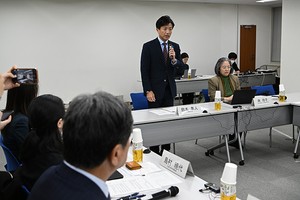THE ASAHI SHIMBUN
January 30, 2025 at 14:53 JST
YASHIO, Saitama Prefecture—The rescue operation for a truck driver trapped in a sinkhole at an intersection here continues to be hampered by the increasing instability of the site.
Additional cave-ins have expanded the size of the original sinkhole and water continues to flow into the area, officials said.
The sinkhole was first formed at 9:50 a.m. on Jan. 28, when a 2-ton truck fell into the 10-meter-deep pit. The driver in his 70s remains stuck inside the vehicle.
Firefighters resumed the rescue operation around noon on Jan. 30. However, the driver’s side of the truck was not visible because it was buried under earth, sand and debris, the officials said.
While checking for safety in the area, the firefighters plan to build a ramp on the road using cranes and other equipment, and use it for heavy machinery that can remove earth, sand and debris from the hole.
The situation has been precarious since the start.
In earlier attempts to reach the trucker, another cave-in occurred near the original hole at 1:10 a.m. on Jan. 29.
Rescue efforts were halted as local firefighters, with support from the Tokyo Fire Department and other agencies, tried to drain the two sinkholes.
On the evening of Jan. 29, they restarted the rescue operation and removed collapsible areas around the sinkholes with excavators.
However, at around 2:30 a.m. on Jan. 30, the road section between the two sinkholes crumbled, and the collapsed part connected the two sinkholes to form one larger one.
The rescue work was again halted while firefighters conducted safety checks and performed other tasks.
Firefighting officials said they have been unable to confirm the size of the current hole.
The cause of the sinkhole is believed to be a burst sewer pipe running beneath the prefectural road.
The Saitama prefectural government conducted an emergency discharge of sewage into a river at around 11 p.m. on Jan. 29 to reduce the flow to the sinkhole area.
The flow rate in sewer pipes in Yashio had increased, and prefectural government officials feared water could overflow again at the site.
The discharged sewage underwent minimal treatment at a pumping station in Kasukabe in the prefecture but did not pass through a sewage treatment plant.
The river where the sewage was released is not used for water supplies, officials said.
The prefectural government continues to ask about 1.2 million people in 12 cities and towns in the eastern part of the prefecture to ease pressure on the sewage system by limiting their use of water in bathing and doing laundry.
(This article was written by Shun Tsunekawa and Masahide Miyajima.)




















A peek through the music industry’s curtain at the producers who harnessed social media to help their idols go global.
A series based on diplomatic documents declassified by Japan’s Foreign Ministry
Here is a collection of first-hand accounts by “hibakusha” atomic bomb survivors.
Cooking experts, chefs and others involved in the field of food introduce their special recipes intertwined with their paths in life.
A series about Japanese-Americans and their memories of World War II